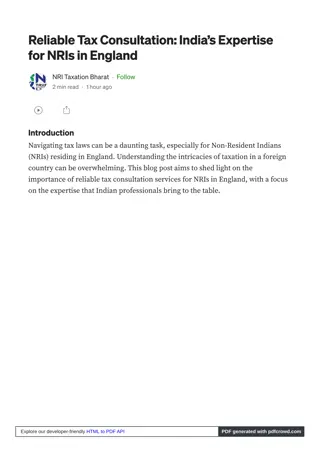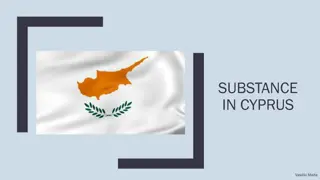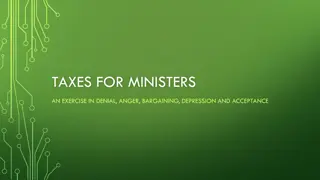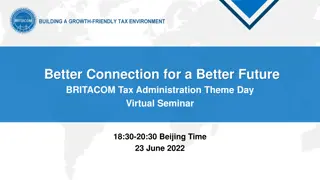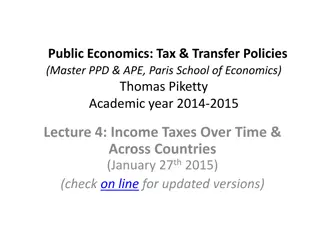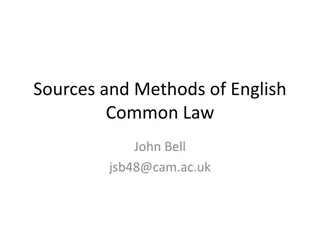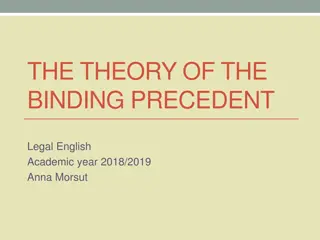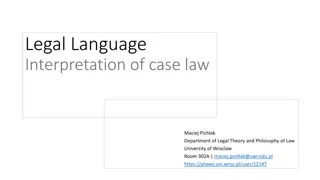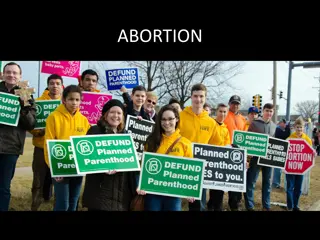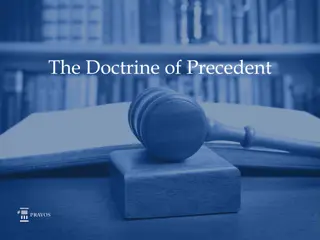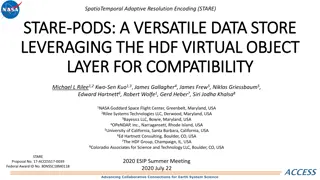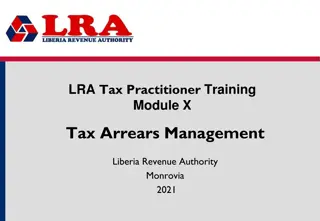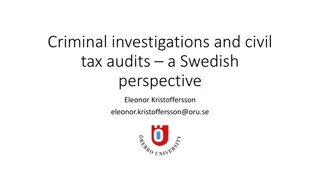The Role of Stare Decisis and Precedent in the U.S. Tax System
The United States tax system relies on the principles of stare decisis and precedent to ensure consistency and fairness. The Constitution grants Congress the power to levy taxes with specific limitations. Federal courts play a crucial role in interpreting tax laws and resolving disputes, with a structured hierarchy involving various types of courts. Understanding these principles and structures is essential for navigating tax matters effectively in the U.S.
Download Presentation

Please find below an Image/Link to download the presentation.
The content on the website is provided AS IS for your information and personal use only. It may not be sold, licensed, or shared on other websites without obtaining consent from the author.If you encounter any issues during the download, it is possible that the publisher has removed the file from their server.
You are allowed to download the files provided on this website for personal or commercial use, subject to the condition that they are used lawfully. All files are the property of their respective owners.
The content on the website is provided AS IS for your information and personal use only. It may not be sold, licensed, or shared on other websites without obtaining consent from the author.
E N D
Presentation Transcript
1 STARE DECISIS AND PRECEDENT: A CASE STUDY THE ROLE OF STARE DECISIS AND PRECEDENT IN THE UNITED STATES TAX SYSTEM JUDGE L. PAIGE MARVEL, UNITED STATES TAX COURT
THE UNITED STATES CONSTITUTION AND THE POWER TO TAX 2 The power to tax in the United States arises from the United States Constitution. The Constitution establishes three branches of government - legislative (Congress), executive, and judicial and outlines their powers. The legislative branch(Congress) has the power to impose taxes but legislative proposals generally do not become law without the President s signature. The executive branch (the President) has the power to make treaties but only with the concurrence of the Senate. The judicial branch has the power to hear cases arising under the Constitution, statutes, and treaties.
TAXING POWER AND LIMITATIONS 3 The Constitution gives Congress the power to impose taxes but places limitations on that power. Direct taxes must be apportioned [U.S. Constitution, art. I, 2, cl. 3]. Other taxes must be uniform throughout the United States [U.S. Constitution, art. I, 8, cl. 1]. Procedural limitations are also imposed, e.g., bills that would raise revenue must originate in the House of Representatives [U.S. Constitution, art. I, 7, cl. 1]. The 16th Amendment specifically authorizes Congress to lay and collect taxes on income from whatever source derived, without apportionment among the States [U.S. Constitution, amend. XVI].
THE ROLE OF THE FEDERAL COURTS IN TAXATION MATTERS 4 The Federal courts are authorized to hear and decide tax cases under certain circumstances. Only a court can declare a statute or administrative interpretation unconstitutional. The Federal courts are often asked to resolve interpretive issues with respect to Federal tax statutes. The tax cases heard by the Federal courts can involve factual issues, legal issues, or mixed questions of fact and law.
THE U.S. COURT STRUCTURE AND WHY IT S IMPORTANT 5 The U.S. court structure is a pyramid with the U.S. Supreme Court at the top, the Courts of Appeals in the center, and the Federal trial courts at the base. There are four types of Federal trial courts that can hear Federal tax disputes: The United States Tax Court, which has national jurisdiction and hears approximately 97% of all civil tax cases filed in the United States; The United States district courts, whose jurisdiction over tax cases is limited by geography and statute (refund jurisdiction only); The United States Court of Federal Claims, which has national jurisdiction but can only hear refund cases; The United States bankruptcy courts, which can hear tax claims only in the context of a bankruptcy proceeding.
THE U.S. COURT STRUCTURE AND WHY IT S IMPORTANT (cont.) 6 Each type of Federal court applies some concept of precedent but what constitutes precedent differs depending on the court. The U.S. district courts generally consider the following to be precedential Supreme Court opinions, the opinions of the Court of Appeals for the geographical circuit in which the particular court is located, and maybe other opinions issued by the district court. The Court of Federal Claims treats Supreme Court opinions and the opinions of the Court of Appeals for the Federal Circuit as precedent but the judges sometimes disagree and do not follow the opinions of other judges on the Court with which they disagree.
The U.S. COURT STRUCTURE AND WHY IT S IMPORTANT (cont.) 8 Each United States Court of Appeal considers the opinions of the Supreme Court and its own opinions to be precedent. The Courts of Appeals are not bound by the opinions of the other Courts of Appeals but may consider them persuasive. The Courts of Appeals sometimes disagree and issue opinions that conflict with each other. That disagreement creates a circuit split , which the Supreme Court will sometimes, but not always, resolve.
PRECEDENT IN THE UNITED STATES TAX COURT 9 The Tax Court has nationwide jurisdiction and its decisions may generally be appealed to any of the geographically-based Courts of Appeals (there are 12 of them), depending on where the taxpayer resides or has its principal place of business. A party to a Tax Court case may also request the Supreme Court to hear the case, generally after a Court of Appeals has ruled on the appeal. As a result, the Tax Court, unlike most other Federal trial courts, has 13 bosses the Supreme Court and each of the geographically- based Courts of Appeals!
PRECEDENT IN THE UNITED STATES TAX COURT (cont.) 10 When Congress created the Tax Court, it enacted a provision that authorizes the Chief Judge to refer cases to the entire Court (Court Conference procedure). If an opinion is subject to Court Conference review and is adopted as the opinion of the Court following that review, it is issued as a Court-reviewed opinion that can include not only the main opinion but also concurring and dissenting opinions. The most important opinions of the Court are court-reviewed Tax Court opinions and Tax Court opinions that are not reviewed by the Court Conference but are designated for publication in the official Tax Court reporter. These opinions [T.C. opinions] are precedential and the judges must follow them if they are squarely on point and cannot be distinguished.
TAX COURT PRECEDENT 11 The following types of decisions/opinions are considered precedential: Supreme Court opinions Court of Appeals opinions from the Court of Appeals having jurisdiction over the appeal See Golsen v. Commissioner, 54 T.C. 757 (1970) Tax Court (T.C.) opinions (both reviewed and unreviewed).
THE PRINCIPLE OF STARE DECISIS 12 The Federal courts generally apply the principle of stare decisis . The doctrine is a policy tool to foster continuity, predictability, and stability in the law. See, e.g., CSX Transp., Inc. v. McBride, 564 U.S. 685, 699 (2011); Hurst v. Florida, __ U.S. __, 136 S. Ct. 616, 623-24 (2016); Johnson v. United States, __ U.S. __, 135 S. Ct. 2551, 2563 (2015); Michigan v. Bay Mills Indian Community, __ U.S. __, 134 S. Ct. 2024 (2014). The doctrine is generally regarded as encouraging reliance upon and faith in the judicial system and its decisions, allowing for the development of predictable rules of law.
STARE DECISIS (cont.) 13 In the United States, the doctrine of stare decisis is not a command, but a guideline to the courts. Under Supreme Court case law, when a precedent is challenged and cannot be distinguished, the Supreme Court will examine several factors to analyze whether stare decisis should apply: The quality of the prior decision s reasoning; The workability of the rules established by the prior decision; The prior decision s consistency with other related decisions; Developments since the prior decision was handed down; and Reliance interests in the prior decision (including the age of the prior decision). See, e.g. Janus v. Am. Fed n of State, Cty., & Mun. Employees, __ U.S. __, 138 S. Ct. 2448 (2018); South Dakota v. Wayfair, __ U.S. __, 138 S. Ct. 2080 (2018).
SOME GENERAL STARE DECISIS PRINCIPLES 14 When Congress can change the results of a Court decision interpreting a statute it enacted, the Supreme Court hews closely to precedent [ Considerations of stare decisis have special force in the area of statutory interpretation. Patterson v. McLean Credit Union, 491 U.S. 164, 172 (1989)]. Conversely, in constitutional cases, the Supreme Court is less likely to apply stare decisis because only the Court is able to correct error in prior case law [The doctrine of stare decisis is at its weakest when we interpret the Constitution because our interpretation can be altered only by constitutional amendment or by overruling our prior decisions . Janus, 138 S. Ct. at 2478]. Poor reasoning and unworkability of a prior rule and/or a change in circumstances can influence the analysis.
SOME GENERAL STARE DECISIS PRINCIPLES/TRENDS (cont.) 15 In certain other types of cases, e.g. Dormant Commerce Clause cases, the Supreme Court takes more of a middle position. As exemplified by the Supreme Court s recent decision in Wayfair, 138 S. Ct. 2096, the Court sticks close to stare decisis because Congress could step in to correct any error, but it is also vigilant to ensure that its default rules do not infringe on the sovereign rights of the States. The Court has begun to stress that in the context of individual liberties, and particularly 1st Amendment rights, stare decisis is at its weakest. Stay tuned!
SOME INTERESTING FACTS 16 The Supreme Court under Chief Justice Roberts (the Roberts Court) (2005-present) has utilized the doctrine of stare decisis more that the Supreme Court under other Chief Justices going back to Chief Justice Warren. To date, the Roberts Court has expressly overruled 18 cases in 13 opinions during its 13 terms. By contrast, the Warren and Burger Courts on average overruled just over 4 decisions per term and the Rehnquist Court on average overruled approximately 3 decisions per term. Source of the above: Jonathan Adler, The Stare Decisis Court?, The Volokh Conspiracy (July 8, 2018) [https://reason.com/volokh/2018/07/08/the-stare-decisis-court]
STARE DECISIS AND THE TAX COURT 17 The doctrine applies in the Tax Court, see, e.g., Hesselink v. Commissioner, 97 T.C. 94 (1991), but often as a defensive weapon by those who support the precedent under attack. Stare decisis rarely controls the result in the Tax Court because much of the Court s work involves statutory interpretation and Congress keeps changing the tax laws. Moreover, the Golsen rule, which dictates that the Tax Court must follow and apply the precedent of the Court of Appeals with venue over the appeal even if it conflicts with the Tax Court s own opinions, creates a hybrid rule that has more impact on the Tax Court s decisional process than the stare decisis doctrine as it is commonly understood. See, e.g., AGH Investments, LLC v. Commissioner, 140 T.C. 73 (2013).


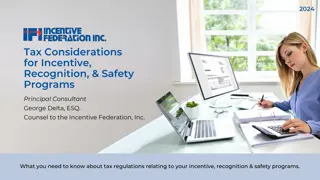
![Town of [Town Name] Real Estate Tax Rates and FY 2024 Budget Summary](/thumb/62211/town-of-town-name-real-estate-tax-rates-and-fy-2024-budget-summary.jpg)
